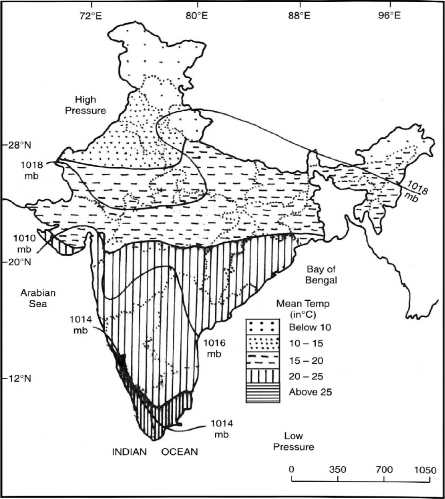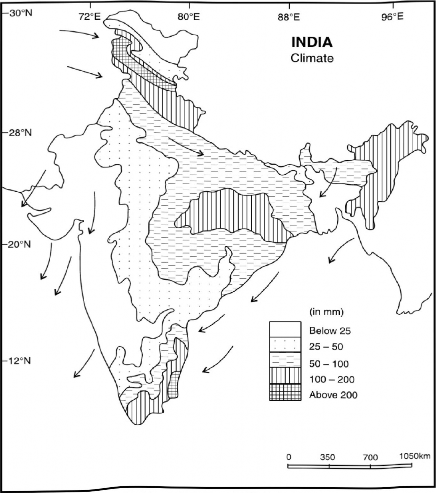I. The Cold Weather Season
The cold weather season in the greater parts of India begins in the later part of November in the north, and by the beginning of December in the rest of the country. The cold weather season is characterised by out-flowing winds, dry and stable air, and clear skies. There develops a high pressure (anti-cyclone) area over north India, and a north-westerly flow prevails down the Indus and Ganges Valleys. During this season the southern branch of the subtropical jet stream is positioned over northern India. The middle latitude westerlies reach down to the surface north of about 25°N. South of this latitude the general movement of air is from the north-east. This north-easterly wind is called the winter monsoon. In Peninsular India, the general direction of wind is from east to west. Because of its trajectory over the Bay of Bengal, the easterlies are full of moisture and yield some precipitation along south-east coastal regions.
During winter season there is a general decrease in temperature from south to north. The isotherms run almost parallel to the latitudes. The 18° C isotherm for the month of January runs in a eastwest direction through the middle of the country, connecting the Tapi estuary in the west and the Mahanadi delta in the east (Fig. 4.12). In the month of January, the north-western parts of the Great Plains of India (Punjab, Haryana, western Uttar Pradesh and Rajasthan) experience less than 15°C mean monthly temperature. The night temperature in the plains of Punjab, Haryana and Rajasthan (Amritsar, Hissar, andjodhpur) occasionally reads below the freezing point, producing ground frost condition. Often, there is a decrease of more than 6°C in the mean temperature, resulting into cold wave in the northern plains of India. In south India, the isotherms tend to bend to the south and run almost parallel to the coast. The western coast is warmer than that of the eastern coast by about 2°C. The diurnal range of temperature is about 15°C in the Great Plains and only

Fig. 4.12 Mean January Temperature
about5°C in the coastal areas of the Peninsula. January is the coldest month in India, especially in northern India. Peninsular India, however, does not have a well defined cold weather season. The mean maximum temperature for the month of January at Thiruvananthapui am and Chennai reads 31 °C and 30° C respectively (Fig. 4.12).
A characteristic feature of the cold weather season is the inflow of western disturbances originating from the Mediterranean Sea. The frequency of these disturbances is 4 to 6 per month between December andjanuary. In north-western region of the subcontinent, winter precipitation is caused by the depressions
that are associated with the westerly disturbances moving out from the Mediterranean Sea. The cold weather precipitation, though small, is highly beneficial to
'Rabi crops. Besides, snowfall from the western disturbances feed the glaciers of the Western Himalayas.
The north-eastern parts of India also get some rainfall during the winter season. Arunachal Pradesh, Nagaland and Assam may get about 50 cm of rainfall during these months (Fig. 4.13).

